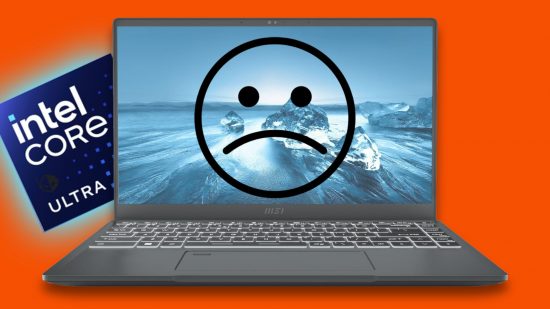Intel‘s new Meteor Lake CPU architecture has just recently come to market in the shape of the Intel Core Ultra lineup of CPUs, and while they offer impressive performance and power consumption figures in some ways, in one particular instance they fall behind previous designs. Specifically, the number of instructions that the chips can process per clock cycle – the instructions per clock (IPC) – is lower than the older Raptor Lake design.
The Intel CPU revelation was discovered by hardware tester, David Huang. He tested the new Core Ultra 7 155H laptop processor and compared it to the Raptor Lake-based Core i7-13700H, AMD Ryzen 7 7840HS and 7840H, and Apple M3 Pro and M2 Pro chips. The tests involved running SPECint 2017 benchmarks on a single core of the chips and comparing this score with the average clock speed of the chips during the tests.
The results David obtained are replicated below:
| CPU name | SPECint 2017 Score | Performance Per GHz |
| Apple M3 Pro | 11.8 | 2.92 |
| Apple M2 Pro | 10.3 | 2.94 |
| Core i7-13700H | 9.6 | 1.92 |
| Ryzen 7 7840HS | 9.2 | 1.8 |
| Ryzen 7 7840U | 8.91 | 1.75 |
| Core Ultra 7 155H | 8.44 | 1.76 |
Setting aside the Apple CPU scores, which aren’t quite so comparable as AMD and Intel’s chips, we can see that the Core Ultra chip falls behind Intel’s previous CPU and one of AMD’s recent options. The difference isn’t huge but such is the nature of CPU design that small gains are significant and all add up.
What does a lower IPC count mean? Well, improving IPC is generally seen as a key goal of CPU (or any other processor, such as a GPU) design. That’s because the higher the number of instructions you can complete per clock cycle, the lower you need to clock your chip to achieve the same level of performance, potentially reducing power consumption and heat output or providing more performance. That means more frames per second per watt when gaming.
That’s why AMD‘s original Zen CPUs were such a revelation compared to previous AMD designs and why Intel‘s first generations of Intel Core i chips were also so lauded – they both massively improved IPC.
As for why we’ve seen this backwards step in IPC with Intel Meteor Lake, it’s difficult to fully pick that apart without further clarification from Intel. However, it’s at least partly possible that Intel simply didn’t need to focus quite so much on this metric for this series of chips. With the company’s latest manufacturing process allowing for high clock speeds and already low power consumption, the chips are already well placed to offer a decent balance of processing speed and battery conservation. Moreover, with much-improved graphics performance and dedicated AI cores, the new designs lean more into providing accelerated performance for a variety of workloads rather than just brute-forcing IPC.
Nonetheless, particularly for gamers, IPC does tend to be a crucial performance metric, so there could be strong reason to opt for an AMD gaming laptop instead of an Intel one right now. Meanwhile, when it comes to desktop CPUs, the Meteor Lake design hasn’t yet been used, with the Intel 14th gen chips using its older Raptor Lake architecture anyway.
For more on our current CPU and laptop recommendations, check out our best gaming CPU and best gaming laptop guides.
